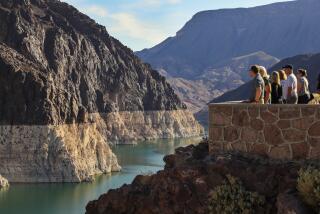Native Wisdom
Mark Twain supposedly said, Whiskey is for drinking, and water is for fighting over, but in the arid terrain of Las Vegas, surprisingly only the first half holds true. And Pat Mulroy, head of the Southern Nevada Water Authority, may just be the reason.
Imagine starting your new job, and one of the first things you do is unify seven fractured water districts and wastewater agencies to form the SNWA in 1991, effectively putting the lid on bureaucratic inertia and laying the foundation for turning water squabbles into platforms for conservation. Now imagine that the area you must serve has an exploding population, adding 400,000 residents since 2002 and attracting 40 million annual visitors. But that wont stop you. In fact, water consumption will actually diminish by 20 billion gallons in your tenure. Tens of thousands will have torn out their lawns, replacing more than 120 million square feet of sod since 1999. Think about itsomehow, you will have persuaded residents to replace enough H2O-guzzling fescue to lay a roll of sod halfway around the Earth.
Not too shabby. Howd Mulroy do it? In a word, xeriscaping. The term combines the Greek word for dry, xeros, with land-scaping to denote a garden based on drought-resistant plants. She is the first to tell you xeriscaping does not mean plunking a cow skull down in a bed of gravel. It means celebrating the kaleidoscope of desert flora that has sprung up in gardens across the Las Vegas Valley, with examples like the deep purple pancake cactus, Opuntia violacea, which bursts into brilliant yellow flowers. It is so difficult to connect to a community as tourist based as we are, says Mulroy. Now when people plan their yards, they do so to exist in harmony with the Mojave Desert.
Mulroy knows that inspiring residents to re-create the splendor of the desert in their own yards is an act of necessity. The Las Vegas Valley averages only four inches of rain a year. Thats about three inches less than Phoenix and 11 inches less than Los Angelescities not known for downpour. Drought conditions are at a crisis point, and given that about two-thirds of the areas water usage goes toward maintaining outdoor greenery, ornamental grass is an obvious target. And Mulroy has bet big on an extraordinary 180-acre site, the Springs Preserve, which strives to create a spiritual and aesthetic connection between residents and their desert landscape.
The parks two main spacesthe Desert Living Center, designed by Lucchesi Galati Architects, and the ORIGEN Experience, designed by Tate Snyder Kimsey Architectsdraw on sustainability designs from around the globe. Such innovations include the use of evaporation towers, like the ones often found in places like Dubai and Qatar, which rely on moisture and the movement of hot air to cool buildings naturally. The parks solar panels, which act as both carport for the parking lot and a major source of energy for the Springs Preserve, are such a sleek and significant structure that they attracted a campaign pit stop from President Obama.
There is a reproduction of a local canyon and an exhibit where a flash flood thunders past containing 5,000 gallons of recycled water. Bathrooms have special faucets and spongy catch basins that reabsorb moisture. Says Mulroy with some pride, The Springs Preserves design, a blend of functionality and art, visually reinforces the central theme of sustainability. When considering architectural designs for the various buildings on site, the review team felt it was critical that the facilities reflect that mission.
Classes are an integral part of Springs Preserve, as educators try to shift the mentality of residents accustomed to the lush gardens of the Northeast and a relationship to the outdoors filtered through pesticides. Jonathan Spears, an award-winning xeriscape architect known as the Turfinator, teaches at the Springs. Snakes? he asks. What about snakes? Would you rather have the rats they eat running around your garden?
Vibrant xeriscaping exhibits dominate the grounds. In one section, two faux houses stand as examples of good and bad neighbors. The profligate home boasts aboveground sprinklers that waste water through evaporation and are ruining the homes stucco walls. In contrast, the other provides a xeriscaped alternative, with an underground irrigation system and a flowering drought-resistant vine.
Farther along, large plots of yellow grasses showcase alternatives to the popular St. Augustine or fescue, which have been imported from wetter climates. In some places, Springs Preserve looks more like a chic landscaping store than a government-run facility, making it even more novel. All of this is balanced with some two miles of trails for visitors to see the plants in their native glory.
Mulroy knew that the first step to making Springs Preserve a reality was to get the backing of area residents. We went to the older families that have benefited from the boom but who felt a sense of loss that it wasnt the same Las Vegas they had grown up with. I told them this was an opportunity to create a unique central parka very desert central park that celebrates this place, its plant and animal life and its heritage. It was as if I had turned on a lightbulb.
Jack Zunino, a landscape architect involved in the planning, also recalls the unexpected public reaction. We had some 50 meetings to educate the community, and the response was unbelievable. Even casino owners were supportive, and they usually dont want to be involved in anything that might make you leave their site.
Many consider the land chosen for Springs Preserve to be the birthplace of Las Vegas. An active spring once ran on the property, hydrating Patayan and Numa Indians, Spanish and American explorers and a Mormon settlement. By 1962, with the population and water consumption growing, the spring waters no longer reached the surface and could only be pumped out through wells. Soon, a freeway was planned, but archaeological findings by a local university professor derailed the project, and in 1978, it was put on the National Register of Historic Places. Twenty-nine years later, Springs Preserve opened to the public.
Still, Mulroy realized throughout her conservation efforts that offering cultural and educational platforms would fall short in persuading all residents to live within the desert aesthetic. Such programs as Water Smart Landscapes, however, literally sell the idearesidents are paid $1.50 for every square foot of grass they replace with desert landscaping. Likewise, SWNA gives rebates for putting in pool covers and other water-savings systems. (Even if residents hire a landscaping company to do the work, their reduced water bills will eventually surpass the costs.)
So far, checks totaling more than $138 million have been issued to residents and businesses, with the money coming from fees paid by developers when they build new housing. On the other side of that carrot is a stick: The Las Vegas Valley Water District charges by a tier system, so that anyone using excessive water pays at higher rates.
Still, some homeowner associations could use a little more coaxing to concede their love affair with conventional turf. Norm Schilling, a former lead groundskeeper at the Desert Demonstrations Garden, which was later replaced by Springs Preserve, came upon the problem when his company, Schilling Horticulture Group, designed the gardens for the home that won SNWAs 2008 award for single-family residential landscape by a professional. Despite the clever work on the groundsincluding framing a deep blue pool with golden Dyssodia, red and yellow Indian blanket flowers and moun-tain marigoldsthe palette stopped short at the sidewalk.
Not only are lawns the prevalent landscape in the gated community, but the local homeowners association requires the easement between sidewalk and street be made of the water-glutton fescue. Its a shame, he says, that even when a desert landscape provides such colorful contrasts, with beautiful fragrant plants that attract butterflies and hummingbirds, the HOA still required such high-maintenance, monotone, non-native turf. Despite SNWA lobbying, Nevada law still gives home-owners associations the right to refuse to replace turf in common areas.
As much as she has accomplished, Mulroy is the first to admit her work has just begun. No matter what lies ahead, SNWA programs have had a profound impact on the area. Of course, if Mulroy wanted a real Vegas challenge, maybe shed lead a conservation effort for whiskey. Fat chance.
NONNY DE LA PEÑA is a writer and producer working in journalism, documentaries and 3-D virtual environments.
More to Read
The biggest entertainment stories
Get our big stories about Hollywood, film, television, music, arts, culture and more right in your inbox as soon as they publish.
You may occasionally receive promotional content from the Los Angeles Times.





